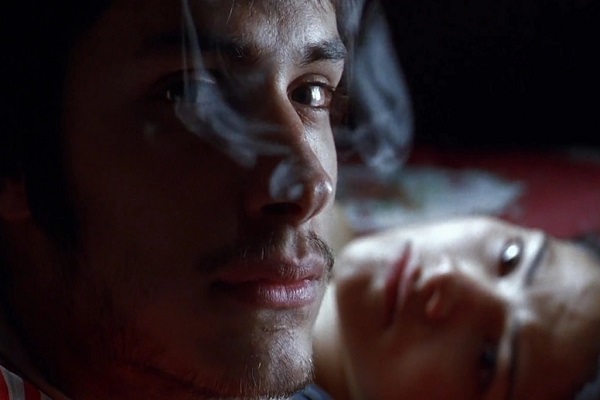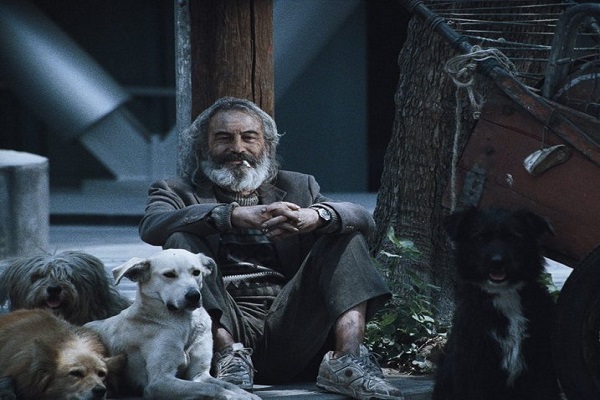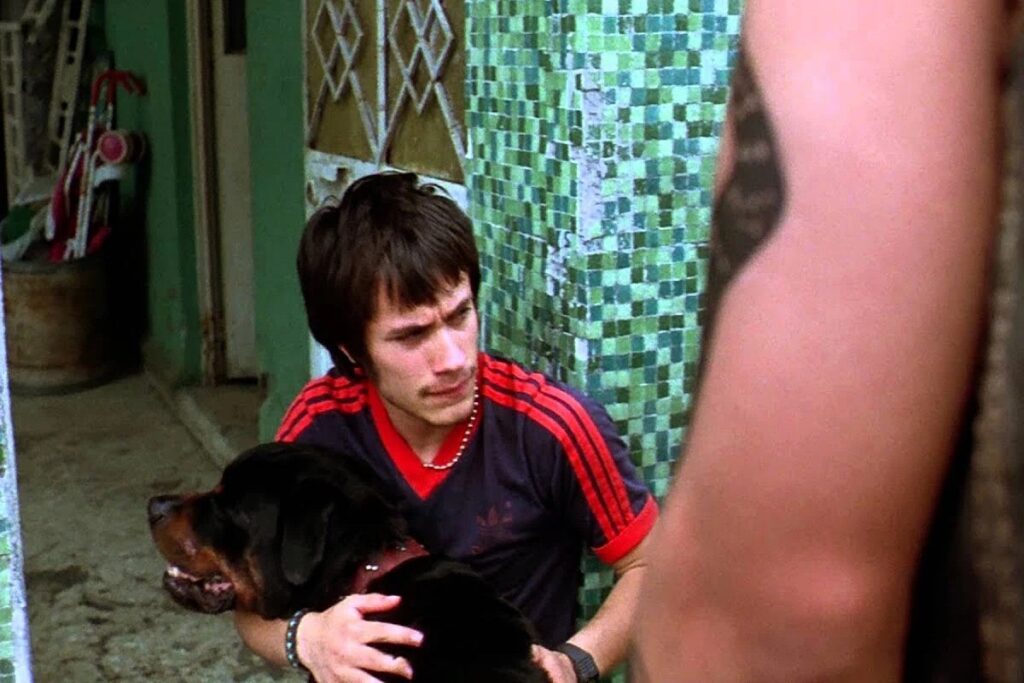Alejandro Gonzalez Inarritu’s debut feature film Amores Perros shows a true and honest picture of Mexico City at the juncture of the 20th and 21st centuries. Apparently, it looks like a violent film, however, the basic objective of cinema is the honest portrayal of society. There is no denying the fact that violence very much existed in Mexico City in the 1990s and early 2000s. So, quite naturally, it became a very important part of Inarritu’s film. He deliberately did not provoke violence. Even though many viewers got upset because of the dog fighting scenes, no dog was harmed during filming. Amores Perros features three separate stories woven together connected by a horrible accident sequence and depictions of dogs.
In the 1st story, a young man exploits his beloved dog in the underworld dog fighting business with the hope of saving enough money so that he can elope with his sister-in-law. In the 2nd story, a rich magazine publisher leaves his family for a beautiful supermodel and then tragedy strikes hard in their life. In the 3rd story, a former communist guerrilla, who now works as a hitman, desperately wants to reconcile with his daughter. The characters in each story dwell in separate sections of society in Mexico City. However, in Amores Perros, filmmaker Alejandro Gonzalez Inarritu weaves them together as the city functions as a single entity and cannot be disintegrated. After all, it is a film about Mexico City and its people. Even though the English title of the film is roughly translated to Love Is a Bitch, the characters in the film desperately seek love. Amores Perros is a film about contradicting emotions like love and betrayal, loyalty and disloyalty, violence and stability, crime and redemption. It is a film about the loss of humanity.

The film starts with a violent car accident sequence in which the characters of the three stories meet for the only time. Apart from this, the only similarities among the three stories are that all the characters live in Mexico City and dogs are featured in each story as important as crucial characters. In the 1st story, Octavio (Gael Garcia Bernal) is in love with his sister-in-law Susana (Vanessa Bauche) and strongly despises his brother Ramiro’s torture of her. One day, Octavio’s dog Cofi kills Jarocho’s dog which takes part in dog fighting. Realizing Cofi’s fighting potential, Octavio decides to make Cofi take part in dog fighting, which will earn him enough money to elope with Susana. After earning enough money, Octavio pays Mauricio, the owner of the dog fighting venue, to beat up Ramiro. Being utterly scared, Ramiro steals Octavio’s money and flees with his wife Susana and their infant son. Octavio becomes heartbroken and struggles financially. During a one-to-one dogfight between Jarocho’s dog and Cofi, Jarocho shoots Cofi when it is about to win. In extreme anger, Octavio stabs Jarocho and tries to escape with Jorge. When Jarocho’s gang chases them, Octavio’s car crashes severely with another car driven by Daniel.
In the 2nd story, a rich magazine publisher Daniel (Alvaro Guerrero) leaves his family to live with his supermodel girlfriend Valeria (Goya Toledo). However, when their love is about to bloom, tragedy strikes hard. Their car crashes with Octavio’s car resulting in Valeria’s severe leg injury. Their dog Richie goes missing under the floorboard. While searching for the Dog, Valeria falls off the wheelchair resulting in arterial thrombosis on her leg worsening the situation of her leg further. The doctor decides to amputate her leg because of the severe gangrene. Finally, Daniel rescues the dog. Valeria returns home in the wheelchair and looks through the window only to find out that the Enchant brand advertisement featuring her has been removed. A heartbroken Valeria sobs profusely. Daniel tries to rejuvenate the relationship with his family.
In the 3rd story, an ex-communist guerrilla named El Chivo (Emilio Echevarria) desperately tries to connect with his daughter Maru who knows that his father is dead. He misses his next target, a businessman, because of the violent car crash between Octavio’s and Daniel’s cars. El Chivo exploits the terrible situation and steals Octavio’s cash and dog Cofi. He nourishes Cofi and brings the dog back to normal life. However, Cofi is a fighter dog, and when El Chivo is out of his squalid hovel, Cofi kills the other stray dogs whom he takes care of. A furious El Chivo is about to kill Cofi but changes his decision at the last moment. This incident transforms him from a hitman to a more reasonable human being. Instead of killing his next target, he ties both his client and target, who are step-brothers, with two separate bars in his hovel placing the gun in the middle of them, and then he leaves his hovel. Their fates remain unknown. He enters Maru’s apartment with a duplicate key and narrates his history on the answering machine which stops recording when he says that he loves her very much. He goes to a mechanic shop and sells the client’s car. El Chivo walks away with Cofi toward the horizon.
One of the most important features of Amores Perros is the absence of fathers. In the 1st story, the father of Octavio and Ramiro is absent. In the 2nd story, Daniel leaves his daughters. In the 3rs story, El Chivo left his daughter Maru long back when she was a child. The absence of fathers aggravates the societal and financial conditions of those families. Over time, those families disintegrate. There is no denying the fact that a father plays a very important part in a family. A family’s well-being is largely dependent on a father much like a mother. So, the absence of a father largely worsens the financial and social stability of a family like the families portrayed in Amores Perros.

Another important point that filmmaker Inarritu raises in Amores Perros is the loss of humanity. When the film was released, viewers across the world were concerned about the dogfighting shown in the film. However, the ill-fated humans depicted on the screen did not garner much sympathy. Viewers rarely asked whether anybody got injured during the filming of the many violent scenes in the film like car chasing, car crashing, robbery, or dog fighting. The same phenomenon is seen throughout the world. When a pet in a rich household is bombarded with luxuries, countless humans remain hungry day in and day out. There is nothing wrong in providing luxuries to animals. However, Inarritu clearly shows that multiple times humans are much more unfortunate than animals.
In Amores Perros, Alejandro Gonzalez Inarritu portrays the unfiltered and uncompromising face of Mexico City where violence was a daily routine in the last part of the 1990s. Robbery, drug business, murder, threats, and kidnapping engulfed the ordinary civilians of Mexico City as well as the entire Mexico. Inarritu had the courage to showcase all those atrocities in his debut feature film. Cinema is a mirror of society. So, as a true cinema artist, he did not shy away from revealing the true face of Mexico City. So, quite naturally, violence became an important element of Amores Perros.
Another major aspect of Amores Perros is dog fighting. After the film’s release, viewers throughout the world were upset and concerned about the conditions of the dogs shown in the film even though the film clearly states that no dog was harmed during the filming. Dogfighting is banned in many Latin American countries. However, it caters to the underworld economy on which the poor section of society is largely dependent. It very much existed in Mexico City throughout the 1990s and 2000s. So, quite naturally, it became a very crucial part of Inarritu’s debut feature film Amores Perros.
In Amores Perros, filmmaker Inarritu vividly shows the class divisions in Mexico City. The characters in each story live in different strata of society. While the magazine publisher Daniel and his supermodel girlfriend Valeria belong to the affluent class, Octavio’s family belongs to the lower middle class. El Chivo is poor and downtrodden. He does not even have a proper home and lives in a squalid hovel with a few stray dogs. Without the accident sequence, the characters in all three stories wouldn’t even meet. Inarritu shows that the paths of many citizens don’t ever intersect even though they belong to the same city. The more prominent the class difference is, the less probability is of meeting with each other. This class division exists not only in Mexico City but all over the world.
Overall, Amores Perros is about love and betrayal. In the 1st story, Octavio and Susana betray Ramiro and engage in a sexual relationship. Later, Susana betrays Octavio and flees with Ramiro. She rejects Octavio’s proposal to elope with him. In the 2nd story, Daniel betrays his family and moves into a lavish apartment with his famous supermodel girlfriend Valeria. But, when Valeria loses her leg as well as her physical charm, Daniel betrays her and tries to rejuvenate his relationship with his family. In the 3rd story, El Chivo too betrayed his family for communist ideology. However, during the twilight years, he desperately tries to reconcile with his daughter Maru. Octavio loves his dog Cofi. But, when he comes to know Cofi’s fighting potential, he exploits Cofi in brutal dog fighting. So, Inarritu’s Amores Perros is a cycle of contradicting emotions like love versus betrayal, loyalty versus disloyalty, ideology versus family, and hope versus despair.
Guillermo Arriaga’s deeply personal screenplay vividly and honestly portrays Mexico City and its people. Multiple incidents in the screenplay are directly taken from Ariaga’s own life. He survived a horrible accident in 1985, which inspired the famous opening sequence of the film. Cofi is inspired by his own dog. The 2nd story of Daniel and Valeria is inspired by one of his friends. He knew a man much like El Chivo during his childhood days. Because of Arriaga’s deeply personal screenplay rooted in Mexico City, viewers across the world could connect to Inarritu’s film easily. A purely local story always has global connections.
Inarritu selected Gael Garcia Bernal for the role of Octavio when he saw him for the very first time. His deep gaze, purple eyes, and simple yet mischievous wolf face caught Inarritu’s attention. In the film also, he loves his sister-in-law Susana and his dog Cofi. However, he does not refrain from betraying his brother by engaging in a sexual relationship with his sister-in-law, and Cofi from exploiting in dog fighting. Goya Toledo as Valeria looks like a real supermodel and her acting after losing her leg touches hearts, especially when she returns home with her leg amputated only to find out that the Enchant brand advertisement featuring her has been removed. Emilio Echevarria as an ex-communist guerrilla and presently hitman delivers outstanding performance. He is ruthless while eliminating the targets but utterly soft and regretful while trying to reconcile with his daughter. Emilio prepared for his role for a very long time, which brought him closer to his pack of dogs. He formed such a strong connection with those dogs that they always followed him during the filming of the scenes.
In Amores Perros, director Inarritu wanted to capture the real raw look of Mexico City. So, he and cinematographer Rodrigo Prieto chose documentary-style handheld cinematography in real locations of Mexico City instead of a studio. Prieto shot the film over a period of 10 weeks in real locations in Mexico City. 9 cameras were set up to capture the car crash sequence from different angles. Inarritu and Prieto went for an extra level of experimentation with the look of the film. They used the “bleach-bypass” process which created brighter colors, higher contrasts, and sharper textures of the film. They also experimented with the film stock and camera movements as per the subject matter of three stories. While grain-structured film stock and aggressive camera movements were used for 1st and 3rd stories, more clean and clear film stock and slow camera movements were used for the 2nd story to give it more of a classical look and feel. Prieto used wide-angle lenses with short focal lengths for the interior scenes of the 1st and 3rd stories to give them raw and claustrophobic looks and feel. When the filming was wrapped up, the editing process, which included Inarritu himself, took more than 9 months. Much of the dynamism and thrilling effects of the film were created during the editing process. It was indeed a mammoth exercise.
Gustavo Santaolalla initially rejected Inarrito’s offer to compose the music for Amores Perros but accepted it after seeing the opening accident sequence of the film. He extensively used the Bolivian ronroco guitar, which is one of the most striking phenomena of the film. Apart from his own soundtracks, Santaolalla used soundtracks of multiple famous bands Control Machete, Nacha Pop, Titan, The Hollies, Cafe Tacvba, and solo artists Celia Cruz and Julieta Venegas. Dog trainer Larry Casanova did an outstanding job. Filming the dog fighting scenes without harming any dogs is not an easy job. In addition to dog fighting, there are multiple scenes in the film involving dogs which were filmed without any issues. Production designer Brigitte Broch created the real raw look and feel of Mexico City on the set. The interior scenes look outstandingly believable. Even though, initially, Amores Perros received negative criticism for the portrayal of violence and dog fighting, over time, it has received widespread critical acclaim all over the world. Amores Perros was nominated for Best Foreign Language Film at the 73rd Academy Awards and 58th Golden Globe Awards. It won Best Film Not in the English Language at the 55th BAFTA Awards.
